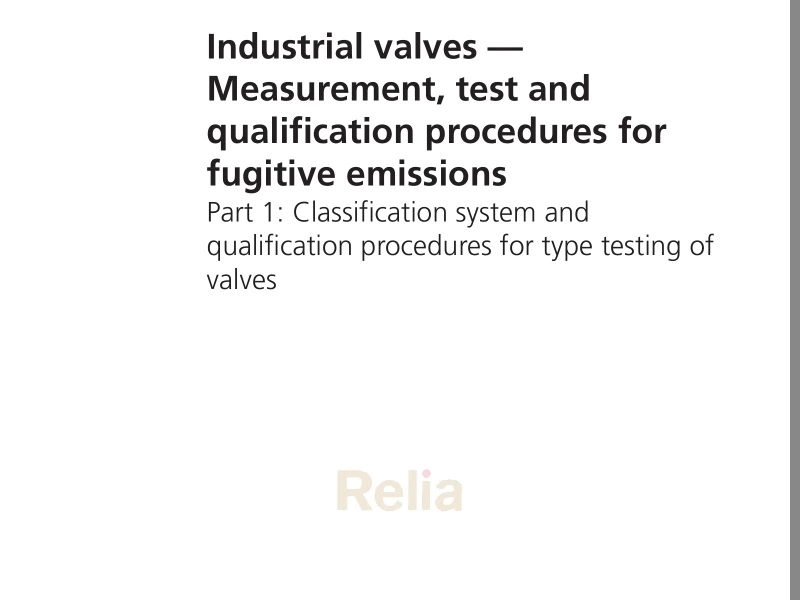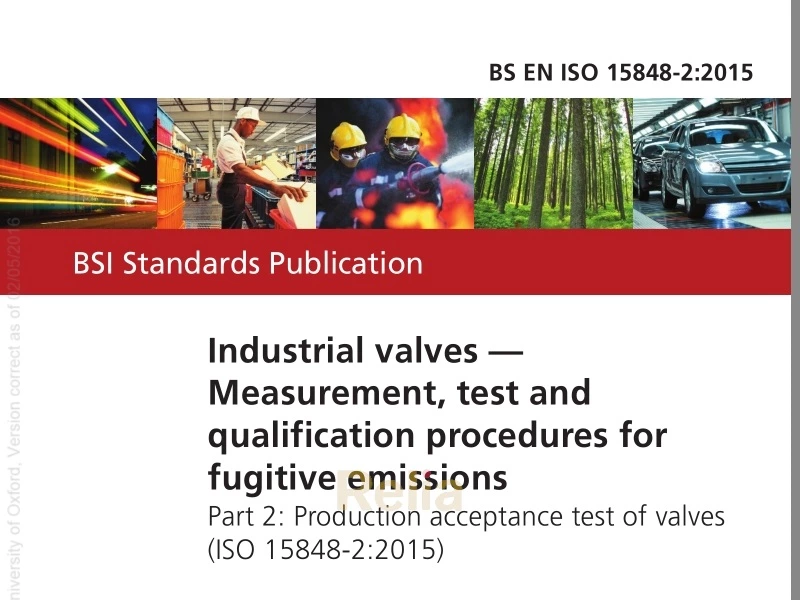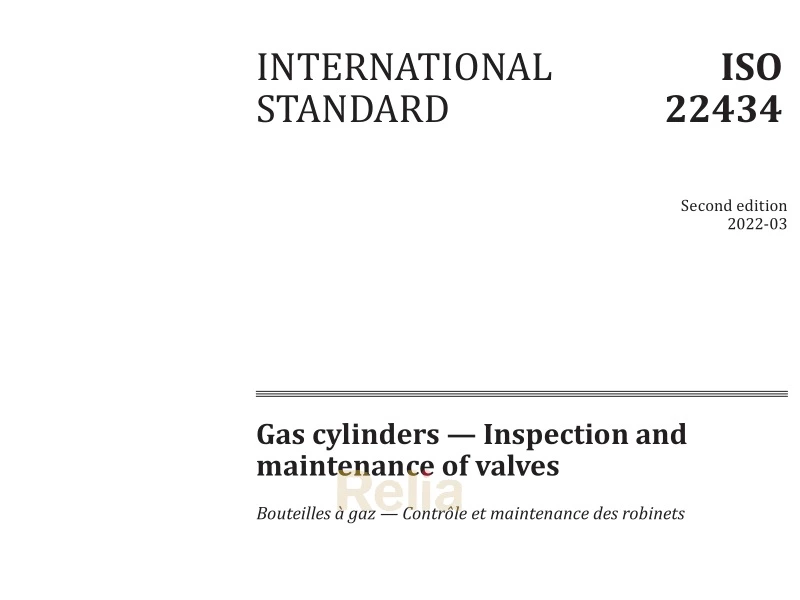ISO 23632: Industrial valves —Design validation- testing of valves
ISO 23632 specifies requirements and acceptance criteria for type testing, in compliance with design conditions, of metallic butterfly and ball valves.
1 Scope
ISO 23632 specifies requirements and acceptance criteria for type testing, in compliance with design conditions, of metallic butterfly and ball valves used for isolating services for all industrial applications, and serves to validate the product design over 205 cycles.
ISO 23632 excludes testing for safety devices, control valves, thermoplastics valves, and valves for water supply for human consumption and sewage (e.g.the EN 1074 series).
This document defines the procedure for extending the qualification of the tested valve to untested sizes and pressure designations of the same product range.
The purpose of this type test is to validate the seat performance within manufacturer given pressure/temperature rating, provided by the manufacturer's technical documentation of the product. This type test verifies torque requirements and the maximum allowable stem torque (MAST), as given in the manufacturer's technical documentation.This type test validates the durability of seat performance and operating torque through mechanical and thermal cycles.
4 Type test
4.1 Test condition
4.1.1 General
The valve manufacturer shall issue a declaration of conformity that the valve to be tested is representative of the products that are being shipped to customers and is not specially prepared for this test.The valve to be tested may be externally coated or painted.
This declaration of conformity shall state that the valve components and the assembled valve have undergone all the manufacturing, assembly and hydrostatic shell test steps of the typical quality control plan provided by the manufacturer.
The allowable seat leakage rates, according to ISO 5208, shall be specified by the valve manufacturer before the start of the type test.
The test equipment shall be appropriately selected to assure it adheres to the specific type test operating conditions.This equipment should also be in accordance with the applicable health, safety and environmental management system.
All measuring instruments shall be calibrated and shall be within their period of validity at the date of testing.
4.1.2 Closure test
Pressure test for the purpose of validating leakage through a valve's closure mechanism shall be measured with dry air or other suitable gas using the mandatory closure test procedure given in ISO 5208 per the applicable product standard.Over 5 MPa(50 bars), self-ignition risks shall be considered when testing with dry air.
For a closure test performed at high or low temperature, the temperature of the exiting test gas shall be measured (before the flowmeter)and verified to be within the calibration range of the flowmeter.For volume flow measurement it is required to correct that measurement for the effect of temperature, or to bring the temperature of the exiting test gas within room temperature.
The perfect gas relationship assuming constant pressure shall be used to determine the equivalent flow rate at room temperature.See I SO 28921-1 for the detailed calculation.
where
T¹ is the test gas temperature entering the flowmeter, in Kelvin (K);
Tz is 298 K, the standard ambient temperature, in Kelvin (K);
Q1 is the test gas flow exiting the flowmeter, in cubic millimetres per second (mm3/s);
Q₂ is the corrected test gas flow exiting the flowmeter at room temperature, in cubic millimetres per second (mm3/s).
Electronic mass flowmeters are not affected by pressure or temperature changes.When such flowmeter is used, test gas pressure and temperature measurements (as well as correction)at the flowmeter is not required.
For a closure test performed at high temperature, the test pressure shall be 1, 1×the maximum rated pressure at high temperature.
4.1.3 Torque measurement
Torque shall be measured by means of a calibrated torque wrench with maximum torque indicator; strain gauge sensor or other appropriate means.Torque measurement equipment shall have a tolerance accuracy lower than or equal to 5 %at the maximum torque measured.
4.1.4 Temperature measurement
The temperature of the test valve shall be measured at the following three locations, as shown in Figure 1 and recorded in a test report.
a) Measurement at location 1 shall be used to determine the test temperature.
b) Measurement at location 2 is for information;any use of insulation shall be detailed in the test report.
c) Measurement at location 3 is used to determine the external valve temperature adjacent to the stem (or shaft)seal(s)for information.For a valve provided with extended bonnet, the thermocouple shall be located on the stuffing box, at the top of the extension.
d)Measurement at location 4 is an option if the measurement location 1 is not possible (except in the case where heating elements penetrate the blind flanges).
All temperatures at location 1 (optionally 4), location 2 and location 3 shall be stabilized before leakage is measured.Temperature at location 1 (optionally 4)shall be stabilized for minimum 10 min prior to eakage measurement (see Figures 1and 2).
Check if the temperature variation is within±5%, or±15 ℃, whichever is less.
4.1.5 Test facility and safety rules
The type tests may be carried out at the valve manufacturing facilities, at the customer facility or at an external qualified facility.However, a set of minimum requirements shall be established for the facility and shall be met for testing to take place at said location.These requirements may include, but are not limited to:
一 demonstration of the capability to perform required tests, inspections, analysis and examinations,
in terms of both personnel qualification and equipment availability;
一 having a quality management system;
一 a health, safety and environment management system;
一 familiarity with the most common valve standards, as well as the reporting and certification of the test results (in appropriate formats).
CAUTION —Pressure testing using gas could be dangerous.Adequate shields or barrier s shall be provided, with warning signs posted in the test area.
4.1.6 Mechanical-cycle classes
The mechanical cycle shall be in accordance with Figure 3.
4.2 Test description
4.2.1 General
The test sequence shall follow Figure 3 .Each numbered box is a measurement step.
The valve shall be opened against the maximum differential pressure at each mechanical cycle.The torque seated valve should be closed to the seating torque provided by the manufacturer at each cycle. The closure test shall be carried out and the opening torque measured at steps 1 to 8 identified in Figure 3.
4.2.2 Test temperatures
The valve mechanical cycling is carried out at room temperature, maximum allowable and minimum allowable temperatures.Testing at maximum allowable and minimum allowable temperatures is required if these temperatures are outside the r oom temperature range.
The test temperature shall be recorded for each leakage and torque measurement.
4.2.3 Closure test
The closure test shall be performed in accordance with 4.1.2.
The obturator shall be moved to the closed position.
For torque seated valves, the seating torque shall be the one provided by the valve manufacturer.Some variation of the seating torque during cycling is allowed ±10 %.
Unidirectional valves shall be tested in one direction only.Symmetric sealed valves that are bidirectional may be tested in one direction only.Asymmetric sealed valves that are bidirectional shall be tested in both directions.
The closure test pressure shall be maintained for a period of time not less than the time specified in Table 1 before closure testing.
Table 1 —Minimum stabilisation time befo re closure testing
| Valve NPS | Time (min) |
| DN 15 to DN 400 (NPS 1z to NPS 16) | 5 |
| DN 450 to DN 600 (NPS 18 to NPS 24) | 10 |
| >DN 600 (DN 24) | 15 |
4.2.4 Unseating torque
After each closure test the unseating torque at the test temperature shall be measured and recorded. The measured torque shall not be greater than the torque given by the manufacturer technical documentation.
4.2.5 Maximum allowab le stem torque (MAST)
The MAST published by the manufacturer shall be applied to the valve at room temperature ensuring that the full operating mechanism is tested.For actuator and gearbox operated valves where the actuator or gearbox torque is less than the valve MAST, the maximum actuator or gearbox rated torque shall be applied.Actual applied torque shall be reported in the test report.In case of a ball valve, a set- up may be required to block the obturator (set-up shall avoid damaging the seats and obturator).
The valve shall then be operated from closed to full open and open to close once to confirm mechanical integrity.After the cycling, the seat integrity shall then be confirmed by a closure test as per 4.2.3.
4.2.6 Post-test examination
On completion of the type test sequence, the valve shall be disassembled, and each component visually inspected, to record any notable wear or any other significant observations.Any crack, important material removal or any degradation that would question the valve integrity or operability are not acceptable.
4.2.7 Qualification
Tested valves shall be qualified when:
一 all steps of test procedures have been satisfactorily completed;
一 all leakage measurements are verified to be equal or lower than the rates specified by the valve manufacturer;
一 all torque measurements are verified to be within the manufacturer published torque values;
一 nothingwas found in the post-test examination that would question the valveintegrity or operability.





